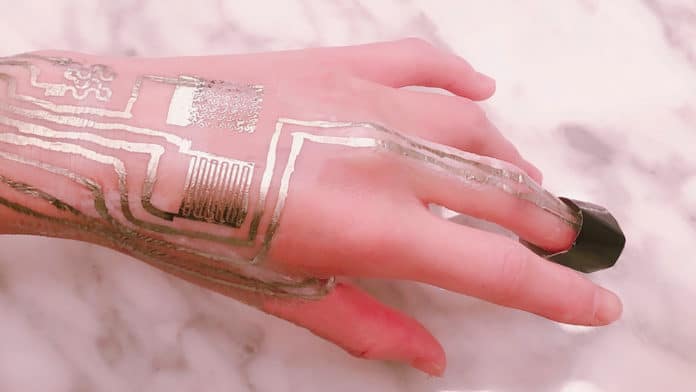Just as the name implies, wearable technology is integrated into wearable objects or directly with the body to help monitor the health and/or provide clinically relevant data for care.
This technology will continue to evolve over the next years, driven by the increasing scientific interest in the huge potential.
Now, an international team of researchers has taken the evolution one step further by printing sensors directly on human skin without heat.
First author Ling Zhang, a researcher in the Harbin Institute of Technology in China and Cheng’s laboratory, said, “In this article, we report a simple yet universally applicable fabrication technique with the use of a novel sintering aid layer to enable direct printing for on-body sensors.”
In past attempts, scientists had developed flexible printed circuit boards for use in wearable sensors. But, printing it directly on the skin was quite tricky because of the bonding process for the sensor’s metallic components. This process is known as sintering that typically requires around 572 degrees Fahrenheit — 300 degrees Celsius — to bond the sensor’s silver nanoparticles together.
The problem is skin surface cannot withstand such a high temperature. To address this, scientists proposed a sintering aid layer that would not hurt the skin and could help the material sinter together at a lower temperature.
By adding a nanoparticle to the mix, the silver particles sinter at a lower temperature of about 212 F (100 C).
Cheng said, “That can be used to print sensors on clothing and paper, which is useful, but it’s still higher than we can stand at skin temperature. We changed the formula of the aid layer, changed the printing material, and found that we could sinter at room temperature.”
This sintering aid layer is consists of polyvinyl alcohol paste — the main ingredient in peelable face masks — and calcium carbonate — which comprises eggshells. The layer reduces printing surface roughness and allows for an ultrathin layer of metal patterns that can bend and fold while maintaining electromechanical capabilities.
When the sensor is printed, the researchers use an air blower, such as a hairdryer set on cool, to remove the water used as a solvent in ink.
Cheng said, “The outcome is profound. We don’t need to rely on heat to sinter.”
“The sensors are capable of precisely and continuously capturing temperature, humidity, blood oxygen levels, and heart performance signals.”
Scientists also linked the on-body sensors into a network with wireless transmission capabilities. This will allow users to monitor the combination of signals as they progress.
The sensor is robust and in tepid water for a few days, but a hot shower will easily remove it. Also, it can be recycled since removal doesn’t damage both the device and the skin.
Scientists are further planning to alter the technology to target specific applications as needed, such as a distinct on-body sensor network placed to monitor the particular symptoms associated with COVID-19.
Other contributors include Hongjun Ji, Senpai Xie, Yaoyin Li, Ziheng Ye, Tiesong Lin, Xiangli Liu, Xuesong Leng, Mingyu Li, Pengdong Feng, Jiaheng Zhang, and Xing Ma, all of whom are affiliated with the Harbin Institute of Technology; Houbing Huang and Xiaoming Shi, both with the Beijing Institute of Technology; and Ning Yi, with the Penn State Department of Materials Science and Engineering.
Journal Reference:
- Ling Zhang et al. Wearable Circuits Sintered at Room Temperature Directly on the Skin Surface for Health Monitoring. DOI: 10.1021/acsami.0c11479
